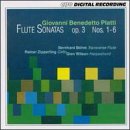| All Artists: Giovanni Benedetto Platti, Rainer Zipperling, Glen Wilson, Bernhard Böhm Title: Platti: Flute Sonatas, Op. 3 (Complete) Members Wishing: 0 Total Copies: 0 Label: Cpo Records Release Date: 2/19/1993 Genre: Classical Styles: Chamber Music, Historical Periods, Baroque (c.1600-1750), Classical (c.1770-1830) Number of Discs: 1 SwapaCD Credits: 1 UPC: 761203902125 |
Search - Giovanni Benedetto Platti, Rainer Zipperling, Glen Wilson :: Platti: Flute Sonatas, Op. 3 (Complete)
 | Giovanni Benedetto Platti, Rainer Zipperling, Glen Wilson Platti: Flute Sonatas, Op. 3 (Complete) Genre: Classical
|
Larger Image |
CD Details |
CD ReviewsPONDERING PLATTI Melvyn M. Sobel | Freeport (Long Island), New York | 10/30/2001 (5 out of 5 stars) "Giovanni Benedetto Platti (1697-1763), rather than following the stylistic musical trends of his time, instead, like very few others, protracted a "bridge" between the Baroque and Classical eras and, in many instances, especially obvious in these works, forayed adventurously into a sort of quasi-Romanticism. The six delightful Op. 3 Sonatas for Flute, Cello and Harpsichord--- all four movements, with the exception of No. 5, which is only three--- are unacademic, fresh, mellow, often playful, singing works. Allegros are radiant, never coarse; sprightly, but always with a subtle hint of nostalgia. Slow movements, particularly fetching, plunge far deeper than one might suppose for this musical period, often "touching" us in the most spontaneous ways. A composer of exquisite taste and melody, Platti, whose Op. 3 was written when he was forty-six years old, is yet another artist who seems unjustly doomed to obscurity; there is hope, though, when an enterprising ensemble such as this--- Bernhard Bohm (Transverse Flute), Rainer Zipperling (Cello) and Glen Wilson (Harpsichord)--- warm and intimate as anyone could want---has the moxie to unearth such insistent treasures. Rarely have flute sonatas been played or recorded so lovingly, or convincingly. [Running time: 67:40]" Elegant, light and airy Leslie Richford | Selsingen, Lower Saxony | 04/01/2009 (5 out of 5 stars) "Giovanni Benedetto Platti (c. 1697 - 1763): Flute Sonatas Opus 3. Performed by Bernhard Böhm, transverse flute, Rainer Zipperling, violoncello, and Glen Wilson, harpsichord. Recorded in March 1990 at the Fürstbischöfliche Residenz in Würzburg, Bavaria (Germany). First published in 1990 as cpo 999 021-2. Total playing time: 67'41".
Having read that these flute sonatas were published in the 1740's, I could hardly believe my ears when I heard them: this is definitely not a set of baroque trio sonatas; the style is "galant", reminiscent of some Haydn and of Johann Christian Bach. Platti was one of the first to use forms which were later to become standard in the pre-classical period; his music is elegant, pleasing, easy on the ear, yet challenging to the musicians. The excellent booklet supplied by cpo contains an essay in which the author makes out a good case for a re-evaluation of Platti from the standpoint of musical history. He argues that if Platti had had the good fortune to be employed by a larger, more important court rather than by the "prince bishop" (what a contradiction in terms!) of provincial Würzburg (Franconia, today Bavaria), he would probably have written larger-scale works rather than mainly chamber music and would today be recognized as a spearhead figure of mid-18th century music. Be that as it may, Bernhard Böhm (pronounce to rhyme with British English "germ"), Rainer Zipperling and Glen Wilson prove themselves more than adequate advocates of Platti's music. The flute, which is put firmly in the forefront by the engineers, has a charming sound somewhere between a recorder and a modern flute: it is always possible to hear that it is made of wood, but it does not sound as antique as some historical flutes on recordings by the likes of Frans Brüggen. Unfortunately, the booklet does not give any details of the instruments; the cello and harpsichord used here are also very pleasant-sounding. The players have mastered the art of decoration, and the dialogue between soloist and continuo is a delight; even after six sonatas, there is not a scintilla of monotony. All is light and airy - definitely music for a sunny day or a warm spring evening!" |

 Track Listings (23) - Disc #1
Track Listings (23) - Disc #1